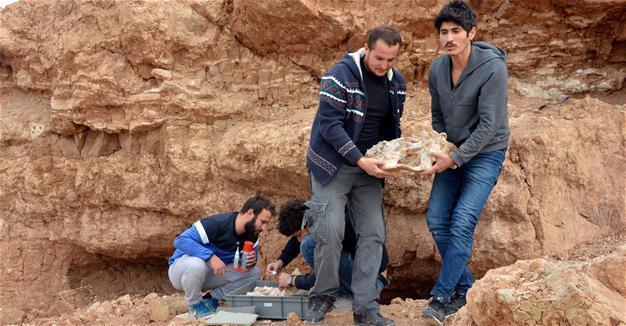Ancient fossils to be displayed in Cappadocia
KIRŞEHİR – Anadolu Agency

AA Photo
Fossil vertebrates of an elephant, rhino, giraffe, antelope, pig, hyena and primate that were found in the Central Anatolian province of Kırşehir’s Kaman district will be displayed to visitors in a new museum set to open in the Cappadocia region.
Ahmet Cem Erkman, an associate professor at Ahi Evran University’s (AEU) anthropology department and the chairman of the Surface Surveys Group, said they found the vertebrate fossils during surface surveys carried out in 2011 in the Kurutlu village on the coast of the Hirfanlı Dam Lake.
He said the surveys later turned into systematic excavations, after the cabinet and the university decided to provide support for the works.
He said they also found bones belonging to a giraffe, rhino, primate, hyena, horse, elephant and small rodents in excavations in the Lodalı Hill, and added that the fossils dated back to the upper Miocene period, some 7 million to 11 million years ago.
Erkman said that after the fossils were displayed to the public, Nevşehir’s Culture and Tourism Directorate got in touch with them to propose exhibiting the fossils in a new museum slated to open in the Cappadocia region.
He said the relevant institutes had accepted the proposal.
“New museums will be established in Nevşehir and Cappadocia, the works are continuing. We will place the fossils in order of importance of the history of nature, at the entrances to the new museums. This way, visitors will be able to see the first settlers of the region. They will also be displayed at the Kaman Kalehöyük Archaeology Museum. We have received demands from museums. Scientific works on animal fossils unearthed in this region will reveal this fauna, bio-diversity, ecology and chronology. Their scientific and visual value is pretty high. Young generations will be able to see how lives were in the past in these museums,” he said.
Erkman said excavations in the region would continue for many years and that they would achieve more important findings by the end of the research. He also said a post-graduate degree program had been opened at Ahi Evran University’s anthropology department. “Students studying this degree will contribute to excavations,” he said.
Erkman said that after nearly two years of works, they had ascertained that the region’s climate was African-style, hot and mild.
“Even though excavations are new here, we believe this place was part of a big river. We will be able to say it after two years. We will be able to give more solid information after three to five years,” Erkman added.
